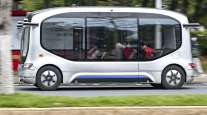Bloomberg News
Lidar Sensor Price Plunge Leads to Orders From GM, Volkswagen

[Stay on top of transportation news: Get TTNews in your inbox.]
When it comes to perception technology, lidar simply can do what other sensors cannot. Developers of automated driving systems of all grades will still need to effectively utilize their camera-based system capabilities, but by operating in concert with lidar, automated driving can function better and make roads safer.
Lidar has been winning over more supporters in the automotive industry as prices rapidly decline. Developers are betting that once their sensors are cheap enough, it’ll be difficult to justify not using lidar in vehicles. BloombergNEF data shows the extent to which lidar prices have fallen and how manufacturers expect cost improvements to continue across all major lidar types.
Lidar technology is changing in that there’s an increasing focus on sensors with few or no moving parts, referred to in the industry as hybrid solid state and solid state. These sensors can do less than the mechanical spinning variety of lidar, but they come at a fraction of the cost. Using a combination of between four and eight solid-state lidar sensors can deliver comparable performance to mechanical spinning lidar at a lower price point. There’s also the added bonus that components without moving parts are more suitable in the automotive environment.
Lidar has historically been used mostly on highly autonomous vehicles, of which there are currently estimated to be around 3,500 in testing or deployment around the world. However, automakers are putting lidar on more production vehicles to improve their advanced driver assistance systems, or ADAS.
There’s growing view in the auto industry that SAE Level 3 automated-driving systems — where the driver can hand over authority to the vehicle under specific conditions — will have lidar. A prime example is the strategy of General Motors.
GM has offered its positively reviewed Level 2 system, called SuperCruise, since late 2017. For its Level 3 system Ultra Cruise, GM is employing lidar from Cepton, a San Jose, Calif.-based supplier that went public by merging with a special purpose acquisition company earlier this year.

TT's Eugene Mulero joins host Mike Freeze to discuss the midterm elections, and what the fight for control of Congress will mean for trucking. Tune in above or by going to RoadSigns.ttnews.com.
A host of other automakers are also looking to lidar as a way to improve their ADAS, including Volkswagen, whose software unit Cariad recently ordered $4 billion worth of sensors from Innoviz Technologies. Chinese automakers, in particular, have adopted the sensors even in vehicle with far lower sticker prices than some of the vehicles available to consumers in the U.S. and Europe.
The more traditional spinning mechanical lidar is still a favorite among many robotaxi developers, which are shooting for a more advanced level of self-driving capability than what’s offered to consumers in production vehicles. The latest designs from U.S. industry leaders such as GM’s Cruise, Amazon’s Zoox, Ford and Volkswagen-backed Argo AI and Google’s Waymo use lidar packages that BNEF estimates cost between $35,000 and $100,000 per vehicle.
While these costs will undoubtedly drop as the technology improves and manufacturing scales, China-based companies including Baidu, Pony.ai and WeRide aren’t waiting for that to happen. The latest technology packages from these companies use only hybrid solid-state and solid-state sensors. The system performance differences are something which we will need to wait to observe, but the cost advantages already seem significant.
Want more news? Listen to today's daily briefing below or go here for more info:




